An epicurean adventure to: The United Kingdom
Our combination of cream, butter, orange zest and nutmeg results in a rich, creamy and flavourful carrot and swede mash that's sure to be enjoyed by even the anti-veg brigade.
These two root vegetables' flavours go particularly well together. Carrots are sweet and a little earthy, while swede is savoury with a rather unique taste, somewhat like a mix of cabbage and turnips. When you mash them together, it creates a delicious blend of sweet and savoury notes, making it a great accompaniment for mains like roast beef or chicken.
Carrot and swede (also known as rutabaga) mash is deeply rooted in British culinary traditions. It has been enjoyed for generations and is considered a classic comfort food.
Both are common root vegetables in the UK and are readily available during the autumn and winter months. Their seasonal availability makes them affordable and easily accessible.
Want to skip the mashing part? Try this honey-roasted carrots and parsnips recipe instead.

Jump to:
- Fast facts - United Kingdom
- What's to love about this recipe
- Key ingredient notes and substitutions
- How to make this mash - Quick summary
- How to slice a swede into small chunks
- Variations
- Serving suggestions
- Storage
- Other vegetable side dishes you might enjoy
- FAQ
- Other vegetable side dishes
- More Christmas recipes
- Recipe
Fast facts - United Kingdom

| Location | The United Kingdom (UK) is located in North-western Europe, comprising four countries: England, Scotland, Wales, and Northern Ireland. |
| Capital | London. |
| Language | In addition to English and Welsh, the United Kingdom is home to a rich linguistic diversity with twelve other indigenous languages spoken, including Gaelic, Cornish, Manx, Scots and three sign languages. English stands as the most widely spoken language, while Cornish is among the least commonly used. |
| Population | Circa 66.8 million people. |
| Trivia | The London Underground, commonly referred to as the Tube, has 270 active stations. However, lurking beneath the bustling network are 40 abandoned and shut-down stations that still haunt the lines. These silent remnants, sitting deep underground, tell tales of changing railway directions, underuse and their role as shelters during the Second World War. |
What's to love about this recipe
- Makes a great side dish to almost any main, especially a Sunday roast and holiday meals like Christmas dinner, Easter lunch and Thanksgiving dinner.
- Can also be used as a base for stews, casseroles and soups.
- These root vegetables are both highly nutritious vegetables that are rich in vitamins and minerals. Carrots are high in beta-carotene, which is converted to vitamin A in the body, while swede is a good source of vitamin C and potassium.
- It's a good low-carb alternative to regular mashed potato.
- Budget-friendly.
- Gluten-free.
- Ideal to make ahead and also freezes really well.
- Counts towards your 5-a-day.
Key ingredient notes and substitutions
**Please see the recipe card at the bottom of this post for the full recipe and list of ingredients.

Carrots and swede
You might wonder what a swede is called where you are in the world:
Rutabaga: This is the most common name for swede in North America, Canada and Australia.
Neep: This is a Scottish term for swede.
Turnip: In some parts of the world, swede is also called yellow turnip or Swedish turnip, although it is not technically a turnip.
Brassica napobrassica: This is the scientific name for swede, which is a member of the Brassica family of vegetables, along with other crops like cabbage, broccoli and kale.
Butter
You can use either salted or unsalted butter for a lovely buttery flavour. If you choose salted butter, it's important to adjust the amount of salt accordingly.
Alternatively, you can add a dash of olive oil.
Double cream
Double cream, or heavy cream, is the magic ingredient that imparts a creamy and rich texture to the mash. However, if you prefer a healthier option, you can omit it altogether or opt for lower-fat alternatives like whipping or single cream.
Seasonings
Salt, pepper and nutmeg, you can adjust these to taste. We also add orange zest from one medium-sized orange. Lemon zest is also a lovely citrussy addition if you'd prefer that to orange.
Black pepper can be swapped for white pepper for a more traditional taste.
Thyme
Thyme is not necessary for the dish, so you can choose to leave it out if you prefer. It adds a bit of extra flavour, but it's completely up to you whether or not to include it. Alternatively, you can replace it with chopped, fresh parsley or rosemary.
How to make this mash - Quick summary
- Wash, peel and slice the vegetables into roughly equal sizes to ensure they cook evenly.
- Put the vegetables in a large saucepan and add enough water to cover them. Sprinkle with a little salt.
- Cook the vegetables for about 25 minutes over medium heat, or until they are soft when tested with a fork.
- Remove the pan from the heat and drain the excess water from the saucepan.
- Add the butter, cream, black pepper, ground nutmeg and orange zest. Place the lid back on (off the heat) for 5 minutes to allow the butter to melt into the warm veg.
- Mash to the consistency of your liking.
You can use a potato masher, a stick blender/hand blender or a food processor, depending on how fine you want the mash to be.
- Spoon into a serving dish and scatter with the optional thyme.
How to slice a swede into small chunks
- Use a vegetable peeler to remove the tough outer skin from the whole swede.
- With a sharp knife, trim off both ends of the swede to create a stable base on the chopping board.
- Slice the swede as you would slice a loaf of bread. Then, cut each slice into strips and chop the strips into small blocks.

Variations
- Feel free to substitute one of the vegetables with something else like parsnips, sweet potatoes or butternut squash for an alternative root vegetable mash.
However, keep in mind that butternut squash has a higher water content, so you might want to reduce the amount of cream used or dry-fry the vegetables over low heat after draining the cooking liquid.
- This swede and carrot mash is an excellent choice as a topping for a cottage or fish pie.
- Experiment with different flavours by using spices like cinnamon, paprika, mixed spice or a hint of ginger. You can also add a pinch of chilli flakes or minced garlic.
- For a low-fat version, omit the butter and cream from the recipe.
- Any leftover carrot and swede mash can be added to soups or stews.
Serving suggestions
- As part of a roast dinner like a Sunday roast, Christmas dinner etc.
- Grilled or roasted meat like grilled chicken breast.
- Meat pies.
- Bangers and mash - replace the potato mash with carrot and swede mash.
- Stews and casseroles.
- Fish and seafood.
- Vegetarian main dishes.
Storage
The mash will keep well in an airtight container for up to three days. Ensure it's completely cooled down before sealing it. Re-heat in the microwave or on the stovetop.
You can freeze the veg for up to 3 months and it does freeze really well. To defrost, place in the fridge the day before to thaw and follow the reheating instructions above.
Other vegetable side dishes you might enjoy
The best honey-roasted carrots and parsnips
Roasted tenderstem broccoli with roasted parsnips.
FAQ
Ensure you have drained off every last drop of the cooking liquid. It helps to put the lid back on for a few minutes to allow the veg to steam dry.
Alternatively, you can dry-fry the veg briefly after you've drained off the water.
Yes, they do have a small amount of carbs, but it's almost half the amount of carbs of regular mashed potatoes.
It contains 18g of carbs to 200g of carrot and swede mash. White potatoes contain 31g of carbs per 200g.
Yes! It's a great way to save time when you have a big meal to cook, like on Christmas day. Make the mash the day before and quickly reheat it in the microwave just before serving.
Instead of using a potato masher, you can puree the veg in a food processor. This also makes it ideal as a nutritious meal for a baby, just omit the cream and butter.
Other vegetable side dishes
More Christmas recipes
The perfect roasted potatoes - All the secret tips!
Christmas cookies with edible wafer paper
The best pigs in blankets with a whisky and honey glaze
Easy Parmentier potatoes (mini roast potatoes)
Roasted tenderstem broccoli with parmesan and pine nuts
The best honey-roasted carrots and parsnips
Recipe

Carrot and swede mash
Ingredients
- 600 grams carrots
- 600 grams swede
- water to cover the vegetables
- 0.5-1 teaspoon salt - adjust to taste
- 30 grams butter - salted or unsalted
- 2-3 tablespoons double cream - adjust to taste
- a few good grinds of black pepper
- a few gratings of nutmeg - or a large pinch of ground nutmeg
- zest from one orange
- a few sprigs of thyme for scattering - optional
Instructions
- Wash, peel, and slice the vegetables into roughly equal sizes to ensure they cook evenly.
- Put the vegetables in a large saucepan and add enough water to cover them. Sprinkle in the salt
- Cook the vegetables for about 25 minutes over a medium heat, or until they are soft when tested with a fork.
- In the meantime, zest the orange and weigh out the butter.
- Remove the pan from the heat and drain the water from the saucepan.
- Add the butter, cream, black pepper, nutmeg and orange zest and place the lid back on for 5 minutes, allowing the butter to melt (off the heat).
- Mash to the consistency of your liking.You can use a potato masher or a food processor for a really fine texture.
- Spoon into a serving dish and scatter with the optional thyme. Serve warm.
**Nutritional data disclaimer**
Please keep in mind that the nutritional information provided below is calculated by a third party and we cannot guarantee the accuracy. We try our best to give you the most accurate information, but we do not take responsibility for errors that may be present. Also, the nutritional value of the recipe may change depending on the exact brands and products used. We recommend that you consult with a qualified healthcare professional or registered dietitian for personalised advice on your dietary needs.
Nutrition
For food safety advice, including guidance on food allergies










Leave a Reply